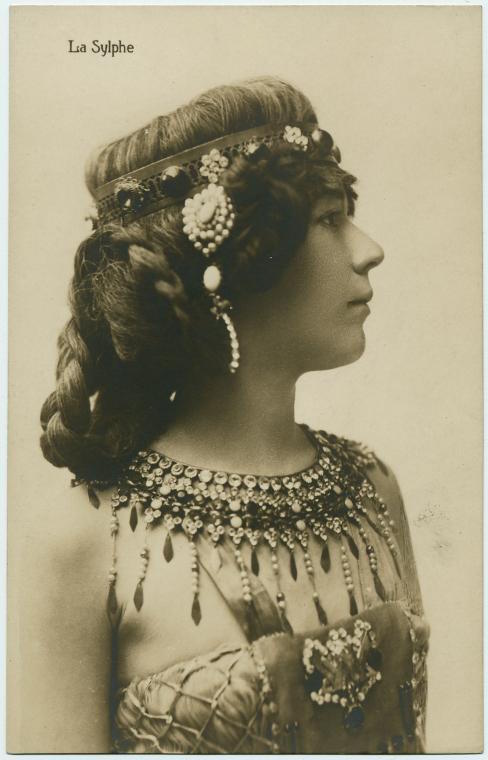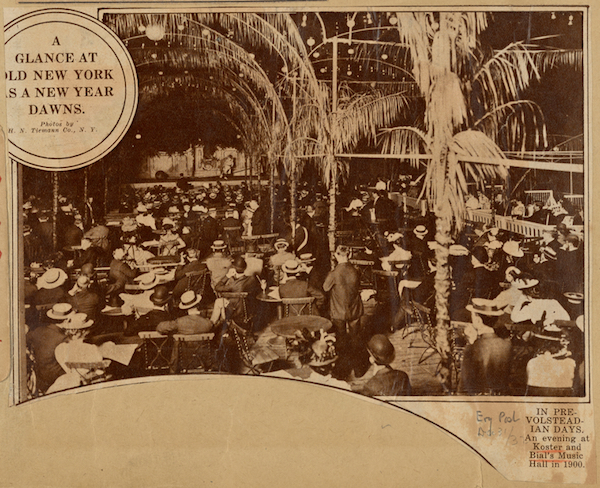
BY TRAV S.D. | For Women’s History Month, we will continue our series on famous vaudeville performers connected with the Tenderloin District. Now long defunct, the Tenderloin was a NYC neighborhood that at its furthest extent ran between 24th and 62nd Streets between 5th and 8th Avenues, thus overlapping with modern Chelsea. The Tenderloin was so-named by a local police captain who relished the nabe for its savory graft. In its heyday of the 1880s through the early 1910s, it was a nightlife mecca full of saloons, dance halls, gambling dens, and bordellos. This month, we will focus on female stars connected with Koster and Bial’s Music Hall, which was located at the present day site of Macy’s Department Store. Koster and Bial’s had the unique distinction of being both posh and somewhat disreputable, presenting entertainment similar in spirit to burlesque at the height of the Victorian era.
One of the major sensations at Koster and Bial’s was a performer who called herself La Sylphe (Edith Lambelle Langerfeld, 1883-1968). The daughter of wealthy German-American inventor Arthur Langerfeld, La Sylphe began to dance seriously at age six. When she was still a child, her mother brought her on two European tours, where she performed in all the great capitals, becoming the toast of London’s Alhambra and Paris’ Folies Bergere.
In 1887 she began an American tour, starting on the West Coast, making the most of her European reputation. Two years later, at age 16, she made a smash (and some scandal) in New York at Koster and Bial’s with a repertoire that included The Vision of Salome, a very early version of what would become a national craze nearly a decade later. The slim-wasted La Sylphe did a version of what was called a “muscle dance,” which some people still call a “belly dance”—flowing, snakelike, suggestive movements that originated in the Middle East and were revolutionary in the Victorian era west. Astonished reviewers said that she seemed “boneless.”
La Sylphe was trained in many movement styles. She also performed ballet, Spanish dances with castanets, and many other types of dances to give variety and exoticism to her act.
In 1908, the Salome craze truly took off, and La Sylphe was booked for the touring editions of the Follies of 1907, and played the big time Keith and Orpheum vaudeville circuits for years. She was also in the 1919 and 1920 editions of George White’s Scandals, and the Greenwich Village Follies. In the late 1920s and early 1930s, she was booked at prestigious institutions like Carnegie Hall and the American Ballet Guild. But it all began for her in the Tenderloin, at Koster and Bial’s Music Hall.
Read about 1,300 more females in show business on Travalanche: https://travsd.wordpress.com/category/ethnicities-identities-representations/women/.

Chelsea Community News is made possible with the help of our awesome advertisers, and the support of our readers. If you like what you see, please consider taking part in our GoFundMe campaign (click here). To make a direct donation, give feedback, or send a Letter to the Editor, email scott@chelseacommunitynews.com.

Pingback: penis enlargement surgery
Pingback: ซื้อหวยออนไลน์
Pingback: tequila with bell ontop
Pingback: go x
Pingback: all slot auto wallet
Pingback: mushroom chocolate bars recipe
Pingback: Firearms For sale online
Pingback: Albino Penis Envy Mushrooms Europe
Pingback: psilocybin mushrooms for sale online
Pingback: Alexa Nikolas Zoey 101
Pingback: url
Pingback: sbobet
Pingback: Key Wall Safe
Pingback: sbobet
Pingback: สล็อตวอเลท ไม่มีขั้นต่ำ
Pingback: เงินด่วน
Pingback: 드라마 다시보기
Pingback: Text inmate
Pingback: maxbet
Pingback: แทงบอลโลก 2022
Pingback: buy marijuana online massachusetts,
Pingback: 90s ecstasy pills
Pingback: cvv dumps 1000$
Pingback: Como Saber El Modelo De Webcam
Pingback: https://wifina.be/regroupement-credit/
Pingback: meoh789
Pingback: digital transformation service providers
Pingback: Gold replica watches
Pingback: cdl job
Pingback: Replica Tag Heuer
Pingback: exchange online plan 2
Pingback: ruger wrangler for sale
Pingback: HP Servis